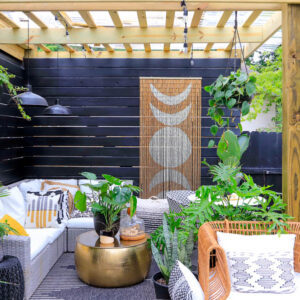Hoping to craft a living room you’ll love now, years from now, and maybe even decades from now? Take a few cues from traditional design. The classic design style is defined by its restrained palette, love of antiques, and commitment to symmetry. And since those elements work in just about any interior, it’s little wonder traditional design has stood the test of time.
“Traditional design should incorporate elements that you’ve seen for generations in home design,” Alessandra Wood, design historian and Vice President of Style at Modsy, says. Think: classic furniture silhouettes, simple patterns, balanced layouts, and museum-worthy art.
“A traditional interior looks like it could’ve been designed 50 years ago or 10 years ago,” Wood adds. “It’s timeless in one sense, but also rooted in traditional forms.”
Since traditional design is so classic and enduring, it’s a style worth getting acquainted with, and once you’ve mastered it, you’ll be crafting spaces that almost never need redecorating. To help you score some classic style in your living room, we’ve rounded up 30 living rooms that have made the most of traditional style—and we’ve cited a traditional living room design idea worth stealing from each of them.
Limit the Colors in Your Palette
Color is welcome in traditional design, but the key is to keep your colors consistent. So commit to a few core shades, and stick to your neatly defined palette.
If you’re not sure which colors to choose, look to your printed pieces for inspiration. “Traditionally coordinating colors are often pulled out of the fabrics utilized,” Miriam Silver Verga, principal designer at Mimi & Hill, says. If one of your statement-makers is made up of three different shades, build your entire palette around that trio of colors.
Stick to a Symmetrical Layout
There are many ways to organize your living room, but if you want your space to feel traditional, keep your layout balanced and symmetrical. “Symmetry and balance are key in terms of layout,” Silver Verga says.
Stick a couch on either side of your coffee table, or arrange your chairs in symmetrical pairs.
Line Your Walls With Classic Wood Accents
Paint isn’t the only way to transform your walls. If you want your space to feel more traditional, unearth some of its built-in architectural elements. Sand down your trim until you can tell it’s made from wood, and stain your wooden doors instead of painting them.
If your home has no built-in elements to unearth, add a few traditional details that suit your home’s architectural style.
Ground Your Space With an Area Rug
Rugs make a classic addition to any space, so it should come as no surprise that they look great in traditional living rooms. “Rugs are an important element of traditional design,” Silver Verga says.
And don’t pick a rug that’s too small, either. “Go big,” Silver Verga adds. “Rugs should be large and even layered.”
Set the Mood With Layered Lighting
No space is complete without thoughtful lighting, and if you layer different fixtures, you can flexibly adjust your living room’s lighting set-up throughout the day.
“Levels of lighting are important for creating ambiance, with sconces and lamps being important elements,” Silver Verga says. Pair a bold chandelier with a few striking table lamps. And layer in other forms of lighting, like wall sconces and art-mounted picture lights.
Keep Your Patterns Tight and Simple
Classic patterns—like stripes and florals—abound in traditional design, and they can be a fun way to add interest to your living room.
“I’d incorporate a few traditional patterns in accents, such as a flame stitch pillow,” Wood says.
Just be sure to keep your patterned pieces simple, neat, and time-honored. “The patterns should be tighter and not painterly,” Silver Verga says. Trade abstract florals for realistic ones, and favor simple prints wherever you can.
Stock Up on Antique Furniture
One easy way to keep your furniture traditional? Stock up on genuine antiques.
“I love incorporating antiques—especially tables, desks, or storage pieces,” Wood says. “It’s nearly impossible to find wood with the same patina and quality in new furniture today, so these pieces are really special in any space.”
Have Fun With Your Upholstery
Too often, we treat the word “traditional” like it’s synonymous with “boring” or “staid.” But traditional upholstery is actually packed with delightful details.
“Seamstress tailoring will be evident throughout, with pleats, skirts, ruffles, and handiwork,” Silver Verga says. That’s right—maximalist details, like ruffles and fringe, line traditional couches and armchairs. So you can have fun while maintaining your timeless traditional aesthetic.
Favor Classic Silhouettes
When stocking up on furniture, look to history for inspiration and favor classic furniture silhouettes wherever you can.
Silver Verga notes that in traditional design, “furniture silhouettes are based on historical styles.” So keep an eye out for furniture you’d think of as classic—like chesterfield sofas, upholstered armchairs, and solid wood armoires.
Make the Most of Ornate Trim
Remember that interior design isn’t just about adding to your space. It’s also about making the most of what you have. So if your home is already pretty traditional, look for ways to draw attention to its classic architectural elements. Could you brighten up your trim with a fresh coat of paint, or dust off your old marble fireplace?
Soften Your Space With Cozy Seating
Living rooms are meant to be lived in, so look for ways to soften up your space. “You can allow the space to feel inviting with ottomans, pillows galore, and plush seating,” Wood says.
By choosing these pieces thoughtfully—and sticking to traditional silhouettes—you can make your space feel welcoming while maintaining its classic appeal.
Organize Your Art Into Groups
Art may be the most classic form of décor there is, so it should make a natural addition to your traditional living room. To keep your space feeling clean and organized, consider grouping your art into symmetrical displays.
“Art in pairs or quadrants feels instantly more formal,” Silver Verga says.
Learn to Love Classic Furniture Details
Traditional furniture is simple in form. But since it’s crafted using classic furniture-making techniques, it’s often loaded with handicraft details. “The furniture will be detailed with nailheads and welting,” Silver Verga says.
Keep an eye out for tufted upholstery, weathered metal hardware, and nailhead-lined couches.
Invest in a Few Old Portraits
Nothing says traditional like a classic painted portrait. “I’d introduce traditional art, such as old portraits or landscape paintings in gold frames,” Wood says.
And if you don’t currently own any portraits—few of us do—you’re bound to stumble upon some when shopping for antique furniture. Sure, they’ll likely be portraits of strangers. But there’s some fun in imagining the lives that the characters in the portraits once lived.
Snag a Pair of Accent Chairs
Silver Verga has some simple advice for your traditional living room: “Have at least one pair of chairs,” she says. Accent chairs add flexibility and style to any living room, and since traditional design is all about symmetry, you’ll want to score yours in a matching pair.
Make Space for Your Favorite Activities
Living rooms aren’t just for lounging and watching TV. You can also use them to entertain guests, play games with family, or log some alone time with your favorite read. So build your living room around your needs.
If cocktail-making plays a key role in your get-togethers, then snag an antique bar cart, line it with traditional barware, and make your at-home bar a focal point in your living room.
Put Your Prettiest Finds on Display
Open storage isn’t a must in traditional homes, but it’s certainly welcome. So take advantage, and snag a bookshelf, sideboard, or curio cabinet fit for showing off your favorite finds.
Welcome Weathered Elements
Any time you’re decorating with antiques, you’re bound to see some wear and tear. And according to Wood, these “weathered finishes” are welcome in any traditional space.
Resist the urge to reupholster a distressed leather chair, polish rusted metal, or refresh a chipped paint job. Instead, embrace the texture—and beauty—these aged pieces add to the room.
Design a Room Worth Entertaining In
Traditional living rooms were built for entertaining, so design a space fit for hosting houseguests. “Traditional style focuses on entertaining multitudes of guests in different kinds of seating,” Silver Verga says. Add flexibility with a varied seating selection, sprinkle in cozy accents, and keep a bar tray at the ready.
Stagger Your Furniture
Traditional furniture isn’t quite as low-profile as the modern finds we love today. To keep your space from feeling cluttered, you’ll want to vary the heights of the pieces you snag. “Heights of furniture should be staggered and varied,” Silver Verga says.
Pair tall armchairs with a low-slung coffee table, and score an accent cabinet that falls somewhere in between the two.
Favor Rich Wood Tones
Wooden furniture is a staple of traditional interiors. And often, that wood is incredibly rich and warm. “Antique pieces are often made of beautiful, rich wood that brings warmth to the space,” Wood says. So snag the richest, warmest woods you can find—and don’t be afraid to mix and match different stains.
Sprinkle in Some Traditional Accents
Sculpture is a time-honored art form. And though your living room probably can’t accommodate a museum-worthy bust, you can certainly line your bookshelves with smaller imitations of the real thing.
Hang a Set of Pretty Drapes
Window treatments bring any space together. So be sure to build them into your traditional decor scheme. “Don’t forget window treatments,” Silver Verga says. “No traditional room is finished without a beautiful set of window treatments.”
Spring for an Extra-Comfy Couch
The couch is the centerpiece of any living room. And if you want your space to feel warm and inviting, it’s worth investing in an extra-cozy option.
“No matter how formal we go, comfort is key,” Silver Verga says. “So have somewhere to sink into in every space.”
Splurge on a Striking Chandelier
If you’ve ever dreamt of dressing up your space with a dramatic chandelier, now is your moment. Chandeliers are a classic lighting option, so they’re sure to (appropriately) transform any traditional interior.
Add Pops of Texture
When your palette is restrained and your print options are limited, there’s one place to play: texture. Wood recommends layering in “textural elements, such as baskets and nailheads” to make your traditional space more dynamic.
Finish Things Off With an Accent Lamp
When crafting your lighting set-up, consider throwing in a few accent lamps—like table lamps and floor lamps with classic pleated shades.
“Beautiful lamps bring a scent of cozy formality to a space, especially when that is all that is lit,” Silver Verga says.
Decorate Your Space in Layers
Don’t feel the need to decorate your space in one fell swoop. “A traditional design style focuses on layers and details,” Silver Verga says.
Take your time decorating, and consider furnishing your space in layers—weaving in antique furniture, then weathered textiles, then decorative accents.
Go All In
One of the things that sets traditional style apart from other aesthetics? “Traditional style has a stronger point of view,” Wood says. So don’t be afraid to commit. Take a risk on a bold (but classic) paint color, line your walls with framed art, and fill your space with traditional accents—like candlesticks and printed rugs.
Sneak in Pops of Personality
“Traditional style doesn’t have to feel stuffy or too formal,” Wood says. So try to have fun with it. Snag a pillow with a dog’s face on it, or score an ottoman with paws. As long as the piece feels classic, it should fit right into your space.
Viewed using Just Read
:strip_icc():format(webp)/traditional-living-room-ideas-2-erin-williamson-design-highland-3-fdb6ee7e1bbf4fc2a8a7f215d5d95640.jpeg)
:strip_icc():format(webp)/traditional-living-room-ideas-1-tyler-karu-charlestown-2-a8654dc8dd30420285fe3094133345ab.jpeg)
:strip_icc():format(webp)/traditional-living-room-ideas-3-jenn-pablo-studio-la-mesa-drive-3019ab22f23b4befb2516aebb27e7780.png)
:strip_icc():format(webp)/traditional-living-room-ideas-15-house-nine-berkshire-577ce6ff1699496c8ff2a4be4a593dfb.jpeg)
:strip_icc():format(webp)/traditional-living-room-ideas-4-rikki-snyder-10-f08d9e29b3c7454aa2569e09a85a07d6.jpeg)
:strip_icc():format(webp)/traditional-living-room-ideas-5-tyler-karu-bath-historic-8edbe1fd0fc14eee8758da49fba4fa9f.jpeg)
:strip_icc():format(webp)/traditional-living-room-ideas-6-katie-hodges-design-beverlyhills-4-825fff89c3674ad4986faa4166cefdec.png)
:strip_icc():format(webp)/traditional-living-room-ideas-7-tyler-karu-charlestown-3-6e0646cfd4f54ed5ac66be02864b2ba6.jpeg)
:strip_icc():format(webp)/traditional-living-room-ideas-8-studio-peake-barons-court-943e1ceb6d9e4cd3a256462e4cc15102.jpeg)
:strip_icc():format(webp)/traditional-living-room-ideas-9-bespoke-only-fort-greene-2-2149af785c634e4cbe10d30a890714ff.jpeg)
:strip_icc():format(webp)/traditional-living-room-ideas-10-house-nine-buckinghamshire-2-0868a2504a7c4d52a23d66c6cd51ae6c.jpeg)
:strip_icc():format(webp)/traditional-living-room-ideas-11-studio-peake-parsons-green-2-0e830459bd5e4f3cbc3bf1e287997a78.jpeg)
:strip_icc():format(webp)/traditional-living-room-ideas-12-katie-leclercq-west-coast-23ec47ce1022457fbb945028486489ee.jpeg)
:strip_icc():format(webp)/traditional-living-room-ideas-13-rikki-snyder-15-6423562ed62345d49bf34c2aca2b6103.jpeg)
:strip_icc():format(webp)/traditional-living-room-ideas-14-erin-williamson-design-california-b08c80c128754f1ab5f27dc74e653ccc.jpeg)
:strip_icc():format(webp)/traditional-living-room-ideas-16-erin-williamson-design-allandale-2-7f9af4b50f6341fb8c083204ca2f78b9.jpeg)
:strip_icc():format(webp)/traditional-living-room-ideas-17-studio-peake-vauxhall-685d5cd2f9df4534baa7ebd2aa1fe7d3.jpeg)
:strip_icc():format(webp)/traditional-living-room-ideas-18-ashley-montgomery-design-mason-44345e582680475faeccf47f3ba59c6c.png)
:strip_icc():format(webp)/traditional-living-room-ideas-19-ashley-montgomery-design-glen-1-9e2d217ae6974d75a2cdb925f53d814e.png)
:strip_icc():format(webp)/traditional-living-room-ideas-20-erin-williamson-design-highland-38222387d27d40e4afdd70216a937b13.jpeg)
:strip_icc():format(webp)/traditional-living-room-ideas-21-rikki-snyder-12-7273d909d4434652a9e01a279ec33647.jpeg)
:strip_icc():format(webp)/traditional-living-room-ideas-22-ashley-montgomery-design-harcourt-4-644c4fbaea214d659ccb2ff9301151c8.png)
:strip_icc():format(webp)/traditional-living-room-ideas-23-house-nine-richmond-6bd462b86ced42df9dfd6767178a8b3d.jpeg)
:strip_icc():format(webp)/traditional-living-room-ideas-24-ferrer-d48dee65e70740a295eea8fc068cbc8a.png)
:strip_icc():format(webp)/traditional-living-room-ideas-25-erin-williamson-design-553c0ba7a48f40738db222898245e2e3.jpeg)
:strip_icc():format(webp)/traditional-living-room-ideas-26-ashley-montgomery-design-ava-2-c58c5fab490e42b185a4c765a07e1852.png)
:strip_icc():format(webp)/traditional-living-room-ideas-27-studio-peake-barons-court-2-b155a0e7fc374f29b915bf792e8e4a5c.jpeg)
:strip_icc():format(webp)/traditional-living-room-ideas-28-house-nine-barnes-mews-2-97874e56f5e24160ba0e5ec7c5f4296d.jpeg)
:strip_icc():format(webp)/traditional-living-room-ideas-29-tyler-karu-bath-historic-2-f3ccf9d98221469c903e4d431272c665.jpeg)
:strip_icc():format(webp)/traditional-living-room-ideas-30-house-nine-barnes-mews-f0d3572e4cc041aba4153080876af835.jpeg)





